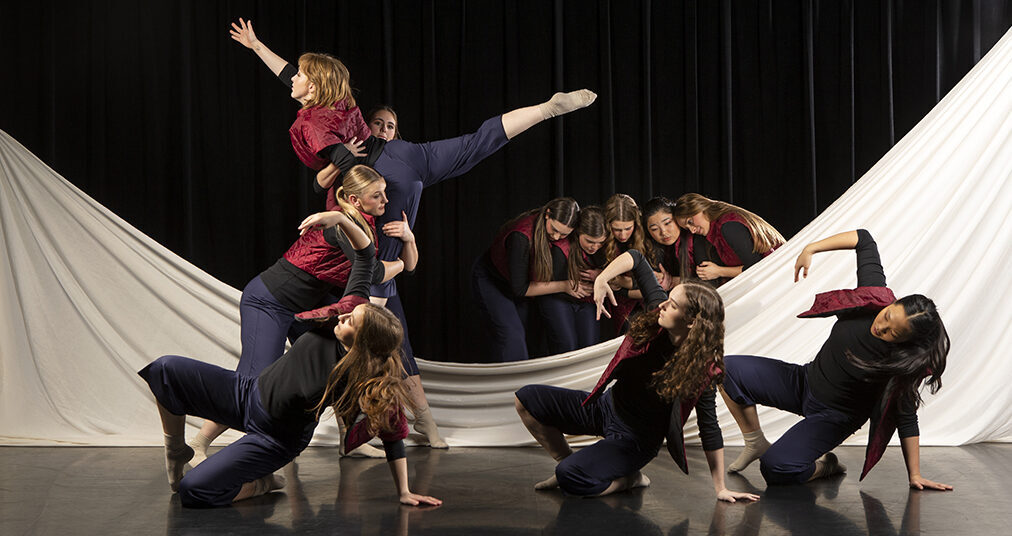‘Journey To Hope’ To Explore Immigration Through Dance, With Sections In Multiple Locations

“Journey to Hope,” a story of immigration through modern dance, will be performed by Dance Science students on May 4 in the courtyard and inside the Liberal Arts and Arts and Humanities Building.
Choreographed by Carisa Armstrong, program director and associate professor, and Christine Bergeron, associate dean for academic affairs and clinical professor for the program, “Journey to Hope” will have free showings at 6 and 8 p.m. Free tickets can be reserved in advance at the ticketing website.
It will be presented in nine sections with original music by composer Richard Hall of Texas State University, with a question-and-answer portion to follow. Seventeen students are featured in the production.
Armstrong and Bergeron said their work will share the perspective of immigrants on their way to their future home. It begins with having to say goodbye to family and their home country, getting proper papers in order, and going where their new future leads them. They wanted to showcase what that process is like and how difficult it can be, Bergeron said.
“The purpose of the piece is to really allow people a moment to contemplate what all that means,” Armstrong said, “and how that might feel for someone who is moving to a new place and embarking on a new journey.”
The idea was inspired by “But Where There’s Hope There’s Life,” a project choreographed by Armstrong and Bergeron that addresses stories of the Holocaust. As part of the research process, Bergeron said they learned more about the displacement of people, and they started to question the immigration process.
“When someone is immigrating to the U.S., there are a lot of ways they might get there,” Bergeron said. “They might get there overseas, they might get there through a truck, they might just get there traveling over desert. And they don’t ever get to stay in one place. This piece is about shifting from one place to the other.”
To showcase the constant motion, the “Journey to Hope” audience will see sections of the work in multiple locations: across the courtyard and inside classrooms and the Black Box Theater in the Liberal Arts and Arts and Humanities Building. Guests will meet at the Black Box Theater to check in. Blankets will be available for guests to sit on in the courtyard, and chairs will be available for anyone who needs them, Armstrong said.
At the courtyard, the dancers will perform in a pool that represents a large body of water that immigrants would have crossed during their travels, Armstrong said. The pool was built by Jam Martinez, the school’s production manager, and Jeff Watson, the school’s theatre facility coordinator. It is 16 feet by 30 feet and will hold about 4 inches of water, Armstrong said.
A section titled “Necessary Goodbyes” explores leaving family behind, Bergeron said. The music accompaniment will also help demonstrate immigrating by water, she said.
“For this section we took gestures of different ways different countries say hello and goodbye,” she said. “And in the music, we asked our composer to incorporate saying ‘goodbye’ in different languages. ‘Conquering the Sea’ incorporates music akin to the children’s rhyme ‘Row, Row, Row Your Boat, to show traveling by water.”
Another section looks at the process of completing paperwork and how long the process can take. To showcase frustration about “drowning in bureaucracy,” Bergeron said students were asked to think about a time they were stressed and in a place that was overstimulating, so they could connect to those moments to help bring that frustration to the surface.
The section also examines “What is freedom?” she said.
“Because once you get that paperwork and you get to be here, what does that actually mean? Because you have probably made these huge sacrifices to be here, and people might have been lost along the way, or you might have to leave large parts of your family behind.
“So, freedom has this double-edge sword in a way — a sense of ‘We got through it, but at the same time we lost people along the way.’ Or, ‘We had to leave people behind, so my freedom is a sacrifice of those other people’s lives.’”
Many of the dancers have not been directly impacted by immigration, so during the creative process they worked on ways the dancers could “connect to the emotional aspect of the work,” Bergeron said.
“We spoke with the dancers about the feelings that come from the loss of a loved one,” she said. “Or how they feel when they are frustrated by something they don’t understand, or leaving someone they wouldn’t see in a long time.”
Armstrong said what makes all art accessible is a concept of universal understanding of each other as humans. With this piece, she said they hope to tell a story through dance in a way that brings people together.
“The human element of this storyline is what we really want people to connect with, because we know what that inner emotion is like. That is what connects us to pieces that don’t have words, or we don’t necessarily know the exact story of what is going on, but we can pick up on the emotion and the connection between people.”
Top photo by Igor Kraguljac Photography.